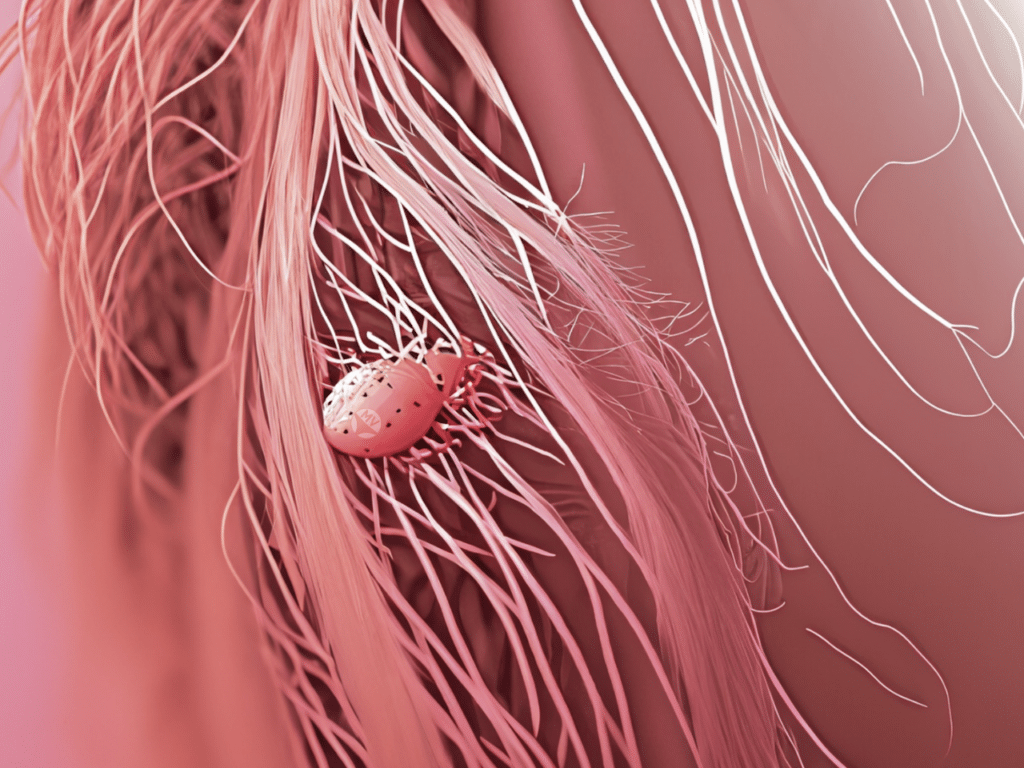Pubic lice (crabs, pediculosis)
Pubic lice (also known as crabs) are small, wingless insects that live on the skin and suck blood. Pubic lice are not the same as other kinds of body lice, and are most often spread by person-to-person contact, including shared clothing or bedding.
Lice are found all over the world, with the lice specific to the pubic area called Pthirus pubis. Pubic lice primarily inhabit the pubic hair around the genitals and anus, and are spread most typically by sexual contact.
Children may catch them through close contact with parents, towels, bedding, and clothing. The chest hair, facial hair (including eyelashes and eyebrows1) and thigh hair can be infested.
Symptoms of pubic lice
- Severe pubic itching on hair-covered areas (pubic hair)
- Visible eggs or lice
- Bites cause small, red pinpoints in the skin
- Bites can cause bluish grey spots on chest, buttocks and thighs
- Possibly swollen lymph nodes
- Secondary bacterial infection on scratching sites
- Eyelash infestations cause eye itching, burning, and irritation
Diagnosis of pubic lice
Pubic lice are found by ultraviolet light or with a microscope. They can leave dark brown specks of faeces on the skin or underwear. And, you can usually see them or comb them out with a special lice removal comb.
Treatment of pubic lice
Pubic lice can be removed by shaving the pubic areas affected. Additionally, pubic lice can usually be treated with shampoos and creams designed for any type of lice – but, treatment results are incredibly variable after decades of resistance-forming ingredients being used.2,3 In fact, researchers are still grappling with how to effectively kill lice, as these tiny little insects have a variety of defence mechanisms, like all insects3.
In lab studies, lice may be totally immersed in a substance, but in real life, this doesn’t happen on a body surface covered in hair, so the treatment isn’t as effective – or not effective at all – out in the wild.
Drugs can be used to treat pubic lice, but you need to really be thorough, since lice can become resistant to certain drugs and be harder to kill.
Some medication can be taken orally to kill the lice via the blood. Sexual partners and if applicable co-sleeping children should also be treated.
Natural treatments/home remedies for pubic lice
There are some studies into essential oils and other oils in treating lice, but as with medications, not all lice are killed all the time, depending on the mechanism by which the oil works and how it is applied.
Essential oils, for example, may work by interrupting the physiological actions of the insect (for example, how an insect detoxifies certain poisonous substances), overwhelming its system and thereby killing it. One study4 found that preparations containing lavender and tea tree essential oils were superior to preparations containing pyrethrins and piperonyl butoxide for head lice.
In another study5 performed only in the lab (in vitro) on head lice, oils of cinnamon leaf, red thyme, tea tree, peppermint, nutmeg, rosemary, and pine were found to be effective when mixed with alcohol, and rinsed in the morning with an essential oil/vinegar/water mixture5.
Other oils, for example, coconut, olive or andiroba oil6, work by what’s known as occlusion: suffocating the insect by covering it in oil for long enough.
In either case, these treatments don’t seem to work all the time in all people, so a combination of treatments may work best if the lice are resistant.
Wash all affected clothing, towels and bedding in hot water, or dry clean. Anything that can’t be laundered or dry cleaned should be kept in airtight plastic bags for two weeks to kill the lice.
Lice carry and can transmit bacteria to humans7,8
Research has shown that body and head lice carry bacteria that causes disease in humans, and is an emerging public health problem in areas with less access to medical care.
This is typically not an issue in Western countries, and is not a cause for concern for most people with lice. The lice use these bacteria to manufacture certain substances, in some cases B vitamins9, they need to survive.
References
- 1.Burgess IF. Human Lice and their Management. Advances in Parasitology Volume 36. Published online 1995:271-342. doi:10.1016/s0065-308x(08)60493-5
- 2.Anderson A, Chaney E. Pubic Lice (Pthirus pubis): History, Biology and Treatment vs. Knowledge and Beliefs of US College Students. IJERPH. Published online February 6, 2009:592-600. doi:10.3390/ijerph6020592
- 3.Burgess IF. Physically Acting Treatments for Head Lice—Can We Still Claim They Are ‘Resistance Proof’? Pharmaceutics. Published online November 10, 2022:2430. doi:10.3390/pharmaceutics14112430
- 4.Barker SC, Altman PM. A randomised, assessor blind, parallel group comparative efficacy trial of three products for the treatment of head lice in children – melaleuca oil and lavender oil, pyrethrins and piperonyl butoxide, and a “suffocation” product. BMC Dermatol. Published online August 20, 2010. doi:10.1186/1471-5945-10-6
- 5.Veal L. The potential effectiveness of essential oils as a treatment for headlice, Pediculus humanus capitis. Complementary Therapies in Nursing and Midwifery. Published online August 1996:97-101. doi:10.1016/s1353-6117(96)80083-7
- 6.Mac-Mary S, Messikh R, Jeudy A, et al. Assessment of the Efficacy and Safety of a New Treatment for Head Lice. ISRN Dermatology. Published online October 30, 2012:1-6. doi:10.5402/2012/460467
- 7.Amanzougaghene N, Fenollar F, Raoult D, Mediannikov O. Where Are We With Human Lice? A Review of the Current State of Knowledge. Front Cell Infect Microbiol. Published online January 21, 2020. doi:10.3389/fcimb.2019.00474
- 8.Amanzougaghene N, Fenollar F, Sangaré AK, et al. Detection of bacterial pathogens including potential new species in human head lice from Mali. Gao F, ed. PLoS ONE. Published online September 20, 2017:e0184621. doi:10.1371/journal.pone.0184621
- 9.Sasaki-Fukatsu K, Koga R, Nikoh N, et al. Symbiotic Bacteria Associated with Stomach Discs of Human Lice. Appl Environ Microbiol. Published online November 2006:7349-7352. doi:10.1128/aem.01429-06






